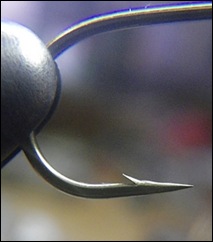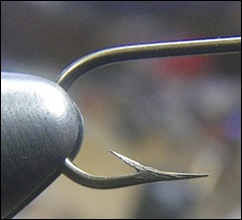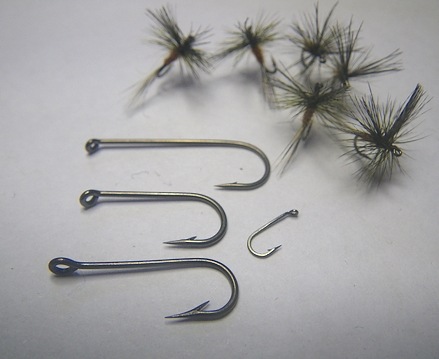With all the boutique players entering into the hook market and many discounters emerging offshore, it’s possible to run afoul of a good hook that fishes poorly.
Most of us don’t consider pinching the barb much of a modification, but the design of the hook often hinges on the barb being present. Plenty of great hooks can be made less so once the barb has been flattened.

At left is an old Partridge CH1A with a traditional Model Perfect bend, hollow point, and small barb. Those delicate little Partridge barbs are easy to flatten but the short point coupled with the Model Perfect bend allows fish to roll right off the hook.
Model Perfect bends aid the fish in that they’re a perfect half circle – making it much easier for the fish to pivot cleanly off the hook.
Sproat and Limerick bends (as do many others) are kinked to lodge the fish in a specific spot, making it a bit less likely for the fish to slide free.
That’s only a marginal advantage as no hook offers anything close to complete protection.
There’s simply not enough straight steel in the above CHIA to offer any margin of safety, with the bend starting just behind the barb a simple headshake will cause the hook to disconnect.
It’s not a function of quality, it’s the design of the hook that doesn’t lend itself to barbless.
 By contrast, a Mustad 4450 with its hollow point, model perfect bend, and enormous barb is much more sinister. Flattening the barb is a little more difficult than the microbarb-style Partridge, but the extra length in the point gives greater purchase and while the Perfect bend allows the fish to pivot – enough straight steel remains in the point and barb area to prevent their sliding off so easily.
By contrast, a Mustad 4450 with its hollow point, model perfect bend, and enormous barb is much more sinister. Flattening the barb is a little more difficult than the microbarb-style Partridge, but the extra length in the point gives greater purchase and while the Perfect bend allows the fish to pivot – enough straight steel remains in the point and barb area to prevent their sliding off so easily.
Both are excellent hooks with the barb intact, but that’s no longer true once the barb is flattened.

Partridge CH1A at top, middle is a Partridge HL1A, bottom is the Mustad 4450, each in size eight. Each style has just a bit more straight steel than the other (as points and barbs differ in each) which assist in holding the fish in place despite the barbless configuration.
As the micro-barb and chemically sharpened needle points have replaced many of the older styles like spear and hollow point, the distance between point and bend has grown smaller. Chemicals bathe the metal and etch on all sides simultaneously – yielding a symmetrical point often called a needle point.
Mechanical sharpening isn’t nearly as efficient, but that selfsame inefficiency (especially when hand sharpened) allows us to displace metal asymmetrically yielding the spear, knife edge, and hollow points. Which can be quite pronounced as in long swoop of the hollow point on the 4450 above.
Shanks lengthen over time and points recede, offering our quarry more leverage than ever. It’s incumbent on us to use the critical eye when enamored of some new hook – as it may have unforeseen consequences when fished.
Tags: Partridge hooks, Mustad hooks, spear point, microbarb, fly tying materials, hook geometry, chemically sharpened hooks, needle point

Excellent point. I would have never figured that one out. Great information.
Thanks.
Another note… on some of those old forged hooks in smaller sizes, one must be EXTREMELY careful crimping the barbs off… lest we end up crimping the whole hook point off.
Not that anything that frustrating has ever happened to me.
That’s only happened to me … a million times. The old forged hooks and some of the newer forged styles are so much more brittle than the softer unforged iron.
Easy on the pounds unless the wire is round …
While you are crimping those barbs, offset them as well. I recall your mention of offset hooks when you stumbled upon Harlee. An offset hook gives a better hook up as more of the barb sticks. You can offset any hook. Of course, offsetting an offset hook is just plain silly. Small dries, nymmphs, and anything swinging benefit from thee offset. Tried and true. Be careful with small fine wire hooks. You can snap the barb off when you offset them. Be gentle.